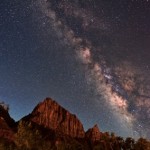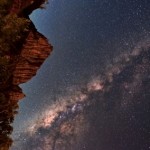 I’m marveling at gaps in consciousness, thanks to the Milky Way. I saw a picture of it on the web, and I froze. Something said Wait: What’s so strange about this picture?
I’m marveling at gaps in consciousness, thanks to the Milky Way. I saw a picture of it on the web, and I froze. Something said Wait: What’s so strange about this picture?
I stared at it, listening. I collected other pictures of it. Still entranced, I researched other cultures’ names for it, other mythologies. Dimly, awareness began to shift. I was sensing, with increasing intensity, the weirdness of its angle: it was a stripe of stars flowing up and down from the horizon – tilted, but up and down. A deep animal sense of disorientation altered my perception of being embodied.
Inner pictures of our spiral galaxy floated into my mind’s eye, in its usual shape as a spinning flat platter. Accustomed as my bodymind was to the notion of up and down, I slowly realized I’d always thought of myself as vertical, with the galaxy around me, my body upright in a galactic hula hoop.
As the truth tumbled upward, letting me accept that I was tilted radically sideways – the only way the Milky Way could appear as a tilted vertical stripe on the horizon – I wondered why it hadn’t always affected me this way. I tried to remember the first time I’d seen that silver river flowing “up.”
That’s when The Gap appeared. I remembered our galaxy being pointed out to me one night, as a child, the kind of remembering that let me re-live the moment. I was frozen then, too, in a different way. It felt flat, two-dimensional. I was awestruck to see with my own eyes something so famous from the books, but I hadn’t yet developed enough spatial instinct or astronomy or self-sense to form a question about it. It didn’t make sense that the Milky Way was a vertical stripe, rather than a halo around the horizon. But something wouldn’t let me imagine the implications. I was conditioned to listen, trusting that everything I was told was useful and true, and I was a more valuable person for knowing about it and having seen it.
 By now I had two Milky Way sightings side by side in my head: childhood’s impression of inexplicable strangeness, an impression that tolerated a huge gap between what I saw and what I understood, and this new perception, feeling my body oddly askew in gravity glue, whirling sideways through an inconceivably vast cosmos.
By now I had two Milky Way sightings side by side in my head: childhood’s impression of inexplicable strangeness, an impression that tolerated a huge gap between what I saw and what I understood, and this new perception, feeling my body oddly askew in gravity glue, whirling sideways through an inconceivably vast cosmos.
Alongside came a third picture – our spiral among thousands of other galaxies – and a fourth picture – an upside-down Earth map, implying there’s no up or down to the galaxy either – and winter solstice got strangely tiny, in context. To measure how tiny, I remembered some numbers about how fast we’re zooming through the universe: 1,000 mph around the earth, 67,000 mph around the sun, with the sun traveling around the core of the Milky Way at 514,000 mph. At what point does the mind collapse in trying to comprehend where the body is, what it’s part of, made of? Is that liberating or terrifying? Or fascinating?
It’s possible that that Gap – the psychological black hole between what I saw as a child and what the truth of it was – saved me from some kind of dis-integration at the time. It would’ve been too much to take in. I’m glad to be able to re-invoke the moment, so I can be happy about the protective time-lag the psyche sometimes offers, waiting for an informed invitation and a safe opportunity to fill in the gaps. Then it can resolve all kinds of dissonance. In the meantime, if experience doesn’t dive below remembering – the protective unconscious behaving like a baby seal in its mother’s pouch, who holds its breath when she dives underwater – stories eventually fill those gaps, lighting comforting fires and candles in the imagination. We are lit by these stories as we whirl through the blackness, listening to physicists and fantasists inside us and around us.
It’s how we are made.
*